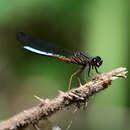Biology
provided by Arkive
Virtually nothing is known of the Kenya dancing-jewel's reproductive biology, life history patterns or feeding behaviour. Nevertheless, there are general biological characteristics of dragonflies and damselflies (Odonata) that are likely to apply. Odonata species start their life as aquatic larvae or nymphs, passing through a series of developmental stages or 'stadia', undergoing several moults as they grow. This larval period can last anything between three months and ten years, depending upon the species. Before the final moult (emergence), metamorphosis occurs in which the larvae transform into the adult form. After emergence, adults undergo a pre-reproductive phase known as the maturation period, and this is when individuals normally develop their full adult colour. Odonata usually feed on flying insects and are generalised, opportunistic feeders, often congregating around abundant prey sources such as swarms of termites or near beehives (2).
There is often fierce competition between males for access to reproductive females, and females typically begin to lay eggs in water immediately after copulation, often guarded by their mate. However, females of some species can store live sperm in their body for a number of days (2).
Conservation
provided by Arkive
There are currently no known conservation measures targeting this species.
Description
provided by Arkive
This rare damselfly has slightly expanded orange legs and a mostly sky-blue abdomen, as well as the large, bulbous eyes, and long, translucent wings characteristic of dragonflies and damselflies.
Habitat
provided by Arkive
Found along montane forest streams, between 1,600 and 2,000 m above sea level (1).
Range
provided by Arkive
Endemic to the Aberdare Mountains and Mount Kenya in central Kenya (1).
Status
provided by Arkive
Classified as Critically Endangered (CR) on the IUCN Red List 2006 (1).
Threats
provided by Arkive
Classified as Critically Endangered on the IUCN Red List, this tiny animal is becoming increasingly threatened by extensive habitat loss and degradation within its range. Forest has largely been cleared between the altitudes at which the species occurs, leaving only fragmented and small secondary forest pockets. Despite the remaining forests being protected as forest reserves, illegal logging, charcoal burning and clear-cutting continue, and urgent conservation measures are desperately needed (1).
Platycypha amboniensis: Brief Summary
provided by wikipedia EN
Platycypha amboniensis is a species of damselfly in the family Chlorocyphidae. It is endemic to Kenya. Its natural habitats are subtropical or tropical moist montane forests and rivers. It is threatened by habitat loss.
- license
- cc-by-sa-3.0
- copyright
- Wikipedia authors and editors

